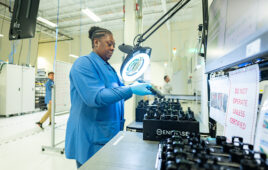In this special edition of Contractor’s Corner, Scott Francis, technical sales manager for Westex: A Milliken Brand, talks through the latest in industry-relevant safety codes that should inform the personal protective equipment selection process and the steps to selecting PPE for an industry like photovoltaic solar. Since 1941, Westex has produced flame-resistant and arc-rated fabrics used in PPE across many industries.
Below is a portion of the company’s Solar Spotlight podcast with Solar Power World, but be sure to listen to the full episode here or on your favorite podcast app.
Can you tell me about some of the basics around NFPA 70E and the arc flash hazard?
NFPA 70E is the standard for the arc flash and shock protection and provides guidance on how to assess the risk associated both with arc flash and shock hazards and both AC and DC electrical equipment; and on how to select the appropriate arc flash and shock PPE. Now, regarding the arc flash hazard in the solar power industry, both AC (alternating current) and DC (direct current) equipment applies with the DC arc flash hazards present in the PV, the photovoltaic cells of the solar equipment before the inverter and the potential arc flash hazard after the inverter. Since additive arc flash analyses for both AC and DC currents are not available, appropriate arc-rated PPE needs to be determined based on DC or AC arc flash analysis, which determines the estimated incident energy in calories per-square-centimeter or determines the PPE category if the PPE category method, which is NFPA 70E, is used.
Select arc-rated clothing PPE that has an arc rating — the arc rating are also measured in calories per-square centimeter — select PPE with an arc rating higher than the estimated instant energy listed on the label, or PPE with an arc rating that meets the PPE category method requirements.
According to the NFPA 70E, when and why should risk assessment be reviewed?
First, when, per NFPA 70E, arc flash risk assessment should be reviewed every five years, or when there has been a change made to the electrical system. This includes checking and updating the accuracy of equipment labels so the appropriate PPE is properly called out on the label. Of course, that’s the why: To protect workers. Make sure that the appropriate arc-rated, arc-flash PPE is indicated on the equipment label. Again, that is done when an accurate incident energy is listed on the label, or the appropriate PPE category is listed on the label if they’re utilizing that method. What method you’re using depends on what’s going to be shown on the label. That’s the key thing.
What are the two methods for selecting PPE with the proper arc rating?
The first table, which is 130.5(C), assists in estimating the likelihood of an occurrence of an arc flash in AC or DC systems for certain tasks on various equipment types and conditions in a “yes or no” format. If the column reads no, you really don’t have a risk. It’s unlikely something’s going to happen, you really don’t need PPE. If the answer is yes under the likelihood of occurrence column with that task and equipment type and condition, an arc flash is likely to occur. It’s not that it might occur or could occur, it’s likely to occur. You need to take on additional protective measures, which is usually going to include the use of PPE. You move on to determine the PPE, you move to a second table.
The second table I talked about, the arc flash PPE category table, has the listed parameters for both AC and DC systems that dictate if these systems can be used. If your parameters don’t meet you can’t really use these. So, they cannot be utilized, the incident energy analysis, also known as the “arc flash study,” is performed. In the solar industry, due to the generation of 1,000 VDC, the incident energy analysis method is used for the DC before the inverter since the 1,000 VDC parameter exceeds the 70E PPE category maximum voltage parameter of 600 V. It lists 600 V in the tables. Well, if you’re at 1,000 V, you can’t use the tables.
If I am selecting the PPE for my team, how do I know which of these two methods I should use?
As I mentioned previously for the PPE category method that can be used, basically for the series of three tables in 70E to be used certain electrical parameter requirements must be met. If the electrical system parameters, such as available fault current and clearing time maximums, are exceeded or the working distance is shorter than the minimum distance, the “incident energy method” shall be required to be used. All else being equal, selecting PPE based on the incident energy analysis method is more effective at ensuring worker safety than the PPE category method.
How can human performance impact risk assessment procedures?
PPE is one of the controls that is most susceptible to human error. The best hazard assessment with the most accurate arc flash incident energy information on the label does no good if human error, which is also lack of human performance, takes place and the arc flash holding PPE is not worn at the appropriate time. Certainly, there is various ways of getting workers to buy into wearing arc flash PPE. But human performance, or lack thereof — human error — also affects the risk assessment method and when to revisit the assessment. Complacency is a safety killer, and it can occur in the assessment procedure or the reassessment procedure.
This podcast is sponsored by Westex: A Milliken Brand






Tell Us What You Think!